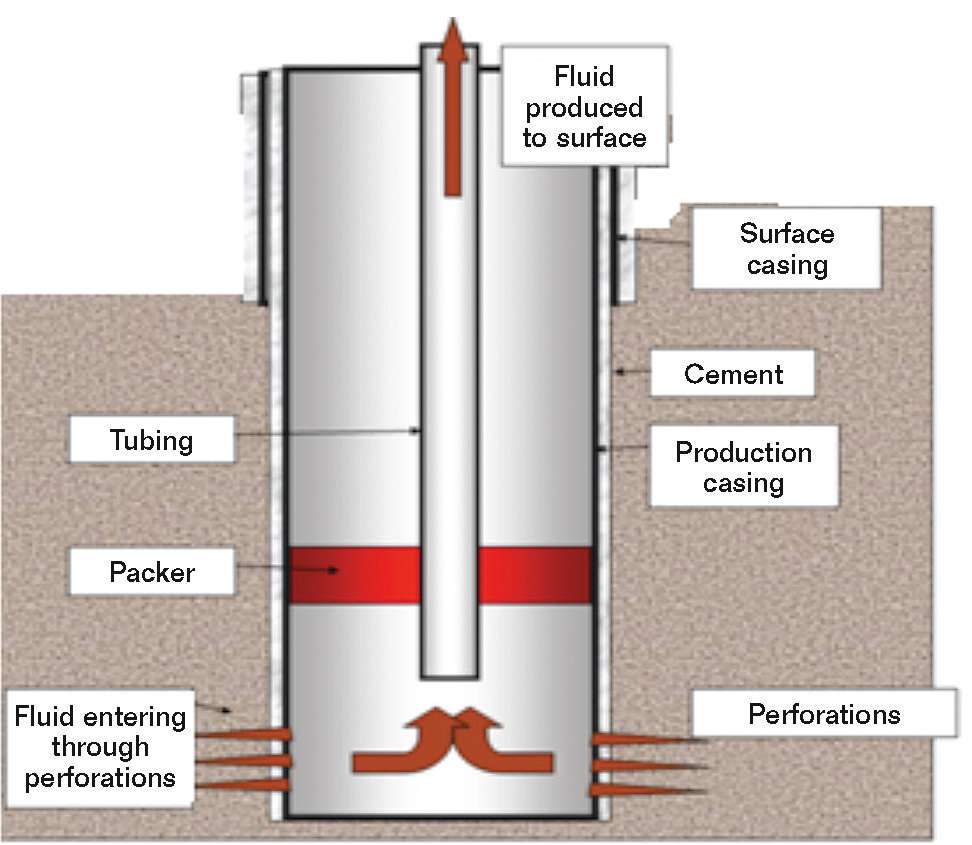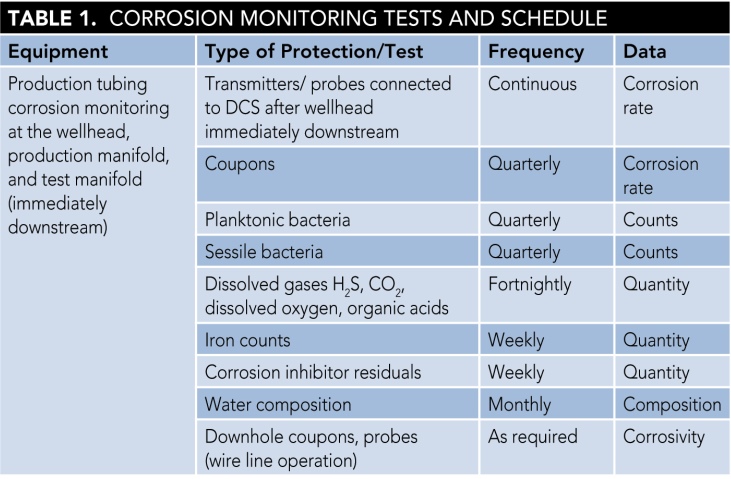In oil and gas drilling, a crew drills the well and puts a casing (large-diameter steel pipe) into the well. The diameter of the casing pipe decreases as it goes further down the well. At the top is the largest diameter pipe, known as the conductor pipe, then the surface casing, intermediate casing, and production casing pipes. Cement is placed in the annulus outside the casing to improve its strength. The production casing is perforated at the bottom (i.e., in the production zone). A smaller diameter tubing is then run through the casing from the wellhead to the production zone of the well (downhole), and a packer is fixed in place to secure the production tubing above the perforations in the production casing. This packer allows the fluids to enter the production tubing, while preventing entry into the upper portions of the casing (Figure 1).

Importance of Production Tubing Corrosion Prevention
In gas wells, production tubing material is selected by specialists based on the corrosivity of the producing fluids. A chemical treatment program may be combined with the selection of a tubing material that is resistant to corrosion. Corrosion prevention of production tubing is critical to avoid hampering production and incurring replacement costs. In addition, production fluids may enter into the annulus between the production tubing and the casing, resulting in corrosion of the casing, which is not designed to withstand contact with production fluids. This can render the well unusable.
Typical Nature of Gas Well Production Tubing
Gas well production tubing, from wellhead to downhole, is typically exposed to large changes in pressure, temperature, water condensation, surface wetting, liquid-to-gas ratio, and other factors. A decrease in pressure will result in the fluid stream being undersaturated with water vapor. Consequently, the dew point of water in the production tubing will occur at some distance from the bottom. From end to end, the condition of the tubing will change considerably, even though it is the same material throughout.
When formation (connate) water is produced, the dew point occurs further down in the tubing, but liquid water is seldom found at the bottom. Higher connate water influx can change this situation to the point where liquid water is present at the bottom; however, with higher gas production rates, the higher draw-down would result in still higher connate water influx for making the bottom hole “wet.”
The prospect of connate water being evaporated by the generation of a pressure gradient is of concern. If the formation water evaporates in the region near the wellbore, it will leave behind any minerals it contained, which leads to scale formation.
Selection of a Suitable Corrosion Inhibitor for Downhole Injection of Gas Wells
Many downhole conditions typically change, including well-to-well, time-to-time, production rates, quantity of formation water, water condensation, pressure changes, and temperature changes. Consequently, conventional inhibitors might not work properly in downhole conditions. A tailor-made inhibitor is often prepared by simulating downhole conditions in a laboratory. Corrosion inhibitors should protect production tubing from gas and liquid phases of well fluids, as well as perform effectively under high-temperature and high-pressure downhole conditions. In addition, the inhibitor should be dynamic and able to rapidly distribute between liquid and gas phases as changes occur in production tubing fluids from the bottom of the hole to the wellhead.
Downhole Chemical Injection Facility for Gas Wells
Downhole injection of chemicals is not simple. A high-pressure injection system is required to pump the corrosion inhibitor. Installing the injection facility at the time of well completion is essential, with the mandrel at the suitable level (below the packer) and the injection line running from wellhead to mandrel. Injection line flow (without blockage) must be confirmed at the time of well completion. Injecting the chemical at the required dosage is also critical. Injecting less than the prescribed amount will not provide corrosion protection, while injecting too much would be wasteful, cause increased expenditure, and could form a downstream emulsion with produced water.
Corrosion Monitoring
At a minimum, checking the concentrations of chlorides, total dissolved solids (TDS), iron content, carbon dioxide (CO2), and hydrogen sulfide (H2S); the pH of the wellhead water; and the quantity of water production from the well is essential. Normally, iron content will give some idea about the corrosion activity of a pipeline in onshore conditions; but in production tubing of a gas well, there will be huge changes in the liquid to gas phases from the bottom of the hole to the wellhead. Water might condense in between or evaporate downhole, which can cause changes in the concentrations of TDS, chlorides, and other ions.
Checking the corrosion inhibitor residuals to verify adequate protection is essential. Placing real-time corrosion rate monitoring probes and periodically monitoring corrosion coupons immediately downstream of the wellhead are important, too. Retrievable corrosion history instruments are also available for downhole corrosion monitoring and can provide data for the period between installation and retrieval. Table 1 lists types of monitoring tests, usage frequency, and type of data collected. A corrosion monitoring schedule is suggested based on experience with gas wells.

Continuous monitoring or pressure alarms in the tube-to-casing annulus represent a proactive approach to corrosion monitoring, because a hole formed in the production tubing can cause production fluids to leak into the annulus with a corresponding increase in the annulus pressure. This can cause corrosion of the well casing, which can be severe. With early detection, corrosion damage can be limited to the production tubing, and the casing can be saved.
Bibliography
Murthy, T.L.N. “A Systematic Approach to Prevent Internal Corrosion of Pipelines.” MP 46, 12 (2007).
Murthy, T.L.N. “Corrosion Control–Loss Prevention.” J. Corros. Sci. and Eng. 12 (2007).
Murthy, T.L.N. “Corrosion Monitoring to Prevent Corrosion Problems.” Coating and Corrosion J., Quarter 4 (2007).
Murthy, T.L.N. “Monitoring of Chemical Treatment Is Essential to Prevent Internal Corrosion.” MP 53, 9 (2014).
Murthy, T.L.N. and G. Kannayya Naidu. “A Sour Gas Problem in Sweet Crude Oil Storage Tanks.” MP 54, 2 (2015).
Peabody, A.W. and R. Bianchetti, ed. Peabody’s Control of Pipeline Corrosion. 2nd ed. Houston, TX: NACE International.
Roberge, P. Corrosion Basics—An Introduction. 2nd ed. Houston, TX: NACE.